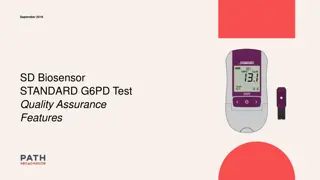Computational Physics (Lecture 18)
Neural networks explained with the example of feedforward vs. recurrent networks. Feedforward networks propagate data, while recurrent models allow loops for cascade effects. Recurrent networks are less influential but closer to the brain's function. Introduction to handwritten digit classification
0 views • 55 slides
Medicaid and CHIP Coverage of New Treatments for Sickle Cell Disease
This communication highlights the Medicaid and Children's Health Insurance Program (CHIP) coverage of new treatments for Sickle Cell Disease (SCD), focusing on the approval of milestone gene therapies, Casgevy and Lyfgenia. It discusses the commitment of CMS to improving healthcare access, quality,
2 views • 13 slides
Understanding Computer Networks: Types and Characteristics
In the realm of computer networks, nodes share resources through digital telecommunications networks. These networks enable lightning-fast data exchange and boast attributes like speed, accuracy, diligence, versatility, and vast storage capabilities. Additionally, various types of networks exist tod
9 views • 12 slides
Understanding FELIX Phase II Run 4 and Versal Prime ACAP Device
Explore the advancements in FELIX Phase II Run 4, leveraging Xilinx Versal Prime ACAP Device, showcased at the 3rd CERN System-on-Chip Workshop. Witness massive improvements in trigger rates, data readout rates, and interactions per bunch crossing. Dive into the hardware details and Versal Prime's c
2 views • 36 slides
Automotive LiDAR System-on-Chip Market Stats from 2024-2033
The automotive LiDAR system-on-chip (SoC) market is expected to be valued at $29.3 million in 2024, which is anticipated to grow at a CAGR of 24.30% and reach $207.5 million by 2033.
5 views • 3 slides
Understanding Artificial Neural Networks From Scratch
Learn how to build artificial neural networks from scratch, focusing on multi-level feedforward networks like multi-level perceptrons. Discover how neural networks function, including training large networks in parallel and distributed systems, and grasp concepts such as learning non-linear function
1 views • 33 slides
Understanding Interconnection Networks in Multiprocessor Systems
Interconnection networks are essential in multiprocessor systems, linking processing elements, memory modules, and I/O units. They enable data exchange between processors and memory units, determining system performance. Fully connected interconnection networks offer high reliability but require ext
1 views • 19 slides
Introduction to Neural Networks in IBM SPSS Modeler 14.2
This presentation provides an introduction to neural networks in IBM SPSS Modeler 14.2. It covers the concepts of directed data mining using neural networks, the structure of neural networks, terms associated with neural networks, and the process of inputs and outputs in neural network models. The d
0 views • 18 slides
Cutting-Edge Fiber to Chip Packaging for Quantum Applications
Cutting-edge research on fiber to chip packaging for quantum applications, showcasing low-loss techniques and advanced photonics devices. The study covers topics such as packaging multiple fibers, fabrication processes, fiber array fusion splicing, and transmission curves for multiple fibers. This w
0 views • 4 slides
Mastering Procedural Writing: Instructions for Chocolate Chip Cookies
This procedure writing guide outlines the essential elements for creating effective instructions, with a focus on how to make chocolate chip cookies. Learn about the importance of clear goals, safety procedures, step-by-step instructions, and key words to use. Follow the provided recipe for a delici
0 views • 7 slides
OACES Chip Seal Workshop Highlights and Insights
Delve into the world of chip seal production and oil rock operations with Billy Scott and Scott Ringham. Learn from their extensive experience at KRC, one of the top aggregate producers in the country. Discover the nuances of different candy bars and the reasons behind their production variations. U
0 views • 20 slides
P-Rank: A Comprehensive Structural Similarity Measure over Information Networks
Analyzing the concept of structural similarity within Information Networks (INs), the study introduces P-Rank as a more advanced alternative to SimRank. By addressing the limitations of SimRank and offering a more efficient computational approach, P-Rank aims to provide a comprehensive measure of si
0 views • 17 slides
Understanding System on Chip (SoC) Design and Components
Explore the world of System on Chip (SoC) design, components, and working flow. Learn about Intellectual Properties (IP), platform-based design, typical design flows, top-down design approach, and the emerging Electronic System Level (ESL) design flow. Discover the essential components of an SoC, su
0 views • 45 slides
Understanding Digital Light Processing (DLP) Projectors
Digital Light Processing (DLP) projectors are display devices based on optical micro-electro-mechanical technology that utilize digital micromirror devices. Developed in 1987 by Larry Hornbeck, these projectors are widely used in classrooms, businesses, digital signs, and even digital cinema project
0 views • 11 slides
Detection of Mutations in EGFR in Circulating Lung Cancer Cells: Study on SARMS Assay and CTC-Chip
This study by Shyamala Maherswaran, Ph.D., and team focuses on characterizing mutations in EGFR in circulating tumor cells using SARMS assay and CTC-chip. The research investigates the effectiveness of these non-invasive methods in analyzing tumors and explores the role of the T790M mutation in resp
0 views • 12 slides
Unified Approach for Performance Evaluation and Debug of System on Chip in Early Design Phase
This presentation discusses the challenges related to system-on-chip design, focusing on bandwidth issues, interconnect design, and DDR efficiency tuning. It explores the evolution of performance evaluation methods and the limitations of existing solutions. The need for a unified approach for early-
0 views • 28 slides
Understanding ChIP-seq Data Analysis in Primate iPSCs
Analysis of ChIP-seq data in primate iPSCs reveals insights into regulatory differences, experimental systems, read subsampling, QC analysis, peak classification, and cross-species comparisons for transcriptional regulation studies. Balanced designs and functional validation of iPSCs contribute to a
0 views • 33 slides
Enhancing NAND Flash Memory Chip-Off Forensic Analysis Reliability
This study focuses on improving the reliability of chip-off forensic analysis of NAND flash memory devices. By identifying error sources, quantifying errors, and proposing mitigation processes, the research emphasizes the impact of storage time and heat on errors introduced in chip-off analysis. The
0 views • 26 slides
Understanding Overlay Networks and Distributed Hash Tables
Overlay networks are logical networks built on top of lower-layer networks, allowing for efficient data lookup and reliable communication. They come in unstructured and structured forms, with examples like Gnutella and BitTorrent. Distributed Hash Tables (DHTs) are used in real-world applications li
0 views • 45 slides
Understanding Networks: An Introduction to the World of Connections
Networks define the structure of interactions between agents, portraying relationships as ties or links. Various examples such as the 9/11 terrorists network, international trade network, biological networks, and historical marriage alliances in Florence illustrate the power dynamics within differen
0 views • 46 slides
Beam Test Results with BCM and TowerJazz CMOS F9 Weekly
Bojan Hiti from Jožef Stefan Institute in Ljubljana, Slovenia conducted a series of tests involving BCM prototype readout chip and TowerJazz CMOS at CERN SPS H6. The experiments included beam tracking, analog readout, and chip configurations for the ATLAS Beam Condition Monitor upgrade. Detailed re
0 views • 19 slides
Enhancing Off-chip Bandwidth Utilization for Improved System Performance
Efficiently coordinating off-chip read/write bandwidth through the Bandwidth-aware LLC proposal yields a 12% performance improvement in an 8-core system across multiple workloads. This approach optimizes DRAM read latency, surpassing existing policies and filling performance gaps while confirming lo
1 views • 36 slides
A Model for Application Slowdown Estimation in On-Chip Networks
Problem of inter-application interference in on-chip networks in multicore processors due to NoC contention causes unfair slowdowns. The goal is to estimate NoC-level slowdowns in runtime and improve system fairness and performance. The approach includes NoC Application Slowdown Model (NAS) and Fair
0 views • 25 slides
A Comprehensive Guide to Common Chip Seal Oils
Explore various types of chip seal oils used for road surfacing, including CRS-2P, CRS-3P, PMCRS-2H, HFE-100-S, HFRS-P2, AC-15P, HFE-150, RS-LTP, and more. Learn about their applications, compositions, and ideal usage conditions such as temperature requirements and traffic intensity. Discover hot ap
0 views • 4 slides
Understanding Network Analysis: Whole Networks vs. Ego Networks
Explore the differences between Whole Networks and Ego Networks in social network analysis. Whole Networks provide comprehensive information about all nodes and links, enabling the computation of network-level statistics. On the other hand, Ego Networks focus on a sample of nodes, limiting the abili
0 views • 31 slides
Investigating Chip-to-Chip Communication Performance on 2.5D Interposer
Investigate the performance of chip-to-chip communication on a 2.5D interposer by analyzing interconnect parameters such as configurations, driver design, trace structure, TSV geometry, and channel modeling. Explore methods like SPICE simulation and MATLAB GUI for performance estimation and optimiza
0 views • 18 slides
Exploring Nanofabrication: Revolutionizing Technology at the Nano Scale
Nanofabrication is a cutting-edge technology that manipulates materials on a minuscule scale, smaller than 100 nm. This process enables the creation of intricate structures like semiconductor chips, lab-on-a-chip devices, and mimicking natural nanostructures. With examples like the Apple A7 chip con
0 views • 11 slides
Evolution of Networking: Embracing Software-Defined Networks
Embrace the future of networking by transitioning to Software-Defined Networks (SDN), overcoming drawbacks of current paradigms. Explore SDN's motivation, OpenFlow API, challenges, and use-cases. Compare the complexities of today's distributed, error-prone networks with the simplicity and efficiency
0 views • 36 slides
Multi-Product Chip Multiprocessor Floorplan Optimization Framework
This research discusses a framework for optimizing floorplans of chip multiprocessors, considering multiple products with varying requirements. The study emphasizes the interdependency between interconnection networks and floorplans, impacting power, performance, and area. By making floorplans chopp
0 views • 31 slides
Control Chip Functionality Overview in Particle Detection Systems
This detailed content discusses the functionality of the control chip in particle detection systems. It covers topics such as error monitoring, logic generation, input/output communication, and more. The control chip plays a crucial role in handling errors, generating actions based on severity, and
0 views • 6 slides
Standard G6PD Test Quality Assurance Guide
This comprehensive guide covers the quality assurance features of the SD Biosensor STANDARD G6PD Test, including instructions on checking the strip, code chip, and control reagents. Learn how to use the check strip, change the code chip, and utilize quality control reagents for accurate testing resu
0 views • 14 slides
Memory Benchmarking of ARM-Based Systems-on-Chip
This study evaluates memory performance in ARM-based Systems-on-Chip (SoCs) for Data Stream Computing (DSC). It discusses key challenges such as energy efficiency, storage capacity, costs, and memory latencies. The relevance of memory performance in military-led research is highlighted, along with t
0 views • 40 slides
Interconnection Networks in Multiprocessing Systems Overview
Explore the intricacies of interconnection networks for multiprocessing systems in Embedded Computer Architecture, covering connecting processors, topologies, routing, deadlock, switching, and performance metrics like bandwidth and latency. Delve into various network types, such as on-chip networks
0 views • 33 slides
High-Speed Hit Decoder Development for RD53B Chip
Development of a high-speed hit decoder for the RD53B chip by Donavan Erickson from MSEE ACME Lab, focusing on data streams, hitmap encoding, ROM splitting, decode engine building, and more. The process involves encoding methods, ROM setup with borrowed software look-up tables, and buffer systems fo
0 views • 33 slides
Understanding Networks-on-Chip (NoC) in Computer Engineering
Networks-on-Chip (NoC) represent a packet-switched communication network designed for on-chip systems, allowing efficient data routing via switches and interconnection links. NoCs aim to apply large-scale network concepts in embedded systems, offering scalability, flexible QoS guarantees, higher ban
0 views • 29 slides
Understanding Interconnection Networks in Embedded Computer Architecture
Explore the intricacies of interconnection networks in embedded computer architecture, covering topics such as connecting multiple processors, topologies, routing, deadlock, switching, and performance considerations. Learn about parallel computer systems, cache interconnections, network-on-chip, sha
0 views • 43 slides
Plant Bioinformatics Studies on ChIP-Seq Data Analysis
Plant bioinformatics researchers conducted experimental analyses and mapped gene regulatory networks using ChIP-Seq data. The studies involved exploring gene expression, regulatory interactions, and transcription factor binding sites. Techniques such as peak calling, motif finding, and peak annotati
0 views • 19 slides
Understanding Deep Generative Bayesian Networks in Machine Learning
Exploring the differences between Neural Networks and Bayesian Neural Networks, the advantages of the latter including robustness and adaptation capabilities, the Bayesian theory behind these networks, and insights into the comparison with regular neural network theory. Dive into the complexities, u
0 views • 22 slides
Challenges and Progress in Children's Health Coverage
The data presented highlights the evolution of children's health coverage in the United States, focusing on uninsured children and enrollment trends in programs like Medicaid and CHIP. Despite significant gains since the enactment of CHIP in 1997, many children remain uninsured due to various factor
0 views • 9 slides
Best Chip Repair Services in Burnaby
If you want the Best Chip Repair Services in Burnaby, visit Apac Auto Glass. They specialize in Windshield Replacement, Chip Repair, ICBC Glass Repair, Door glass repair, and more. Their business is not just about excellence; it's a reflection of the
1 views • 6 slides







































